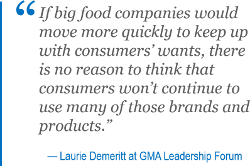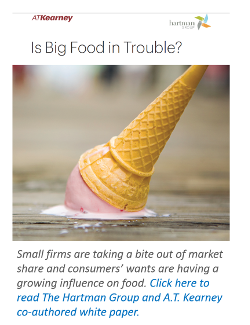Is a reckoning at hand for big food companies?
Highlights from The Hartman Group’s participation at the 2016 GMA Leadership Forum

Big food is not getting its fair share. It’s not showing the revenue growth that it should, given its current valuations. Conversely, consumers are changing, and they don’t see big food companies changing with them. At some point there is going to be a reckoning — soon.
This conundrum facing big food was at the heart of a panel discussion at the 2016 GMA Leadership Forum in White Sulphur Springs, West Virginia, this past July 31. The Hartman Group’s CEO, Laurie Demeritt, was invited to join consultants from A.T. Kearney and Black Monk Consulting and a food executive from Cargill to deliberate the issues and posit ways forward for big food companies.
The North American and global CEOs, presidents and senior executives in attendance at the invitation-only forum were presented a sobering picture of the struggles facing the food and beverage industry’s biggest companies juxtaposed with consumers’ changing desires and behaviors.
The big question during the panel segment, Charting a Recovery for Big Food: Why do consumers hate big food?

“They don’t,” according to Demeritt. “This isn’t an outright rejection that they hate big food; it’s that they are saying ‘I’m changing and looking for things that are healthier,’ and big food companies aren’t offering those options to them. So consumers are looking elsewhere for them.”
The upside for big companies is that consumers don’t have some sort of vendetta against them.
“If big food companies would move more quickly to keep up with consumers’ wants, there is no reason to think that consumers won’t continue to use many of those brands and products,” asserted Demeritt in the panel discussion.
Consumers are expecting more from their foods and beverages and from the companies providing them, reflecting social, economic and cultural shifts that are reshaping their eating habits. Demeritt said, "Who we are, what we do, how we shop and what we value are morphing. Acknowledging these macro dynamic shifts is essential to understanding eating culture and eating occasions today."
According to Demeritt, examples of these macro shifts include:
- Who we are is changing: There are fewer households with kids, more single-person households and we are witnessing the rise of men as primary shoppers.
- What we do: We are eating alone and snacking more, and meal rituals are diminishing. We are increasingly turning to the food service sector to satisfy our food needs and wants.
- How we shop: Multi-channel shopping is now the norm, and immediate consumption is rising.
- What we value: We live in a changing culture of health and wellness where fresh is the symbol of quality in food and beverage, and there is greater appreciation for personalized, customized and global foods.
These shifts have led to a dynamic modern food culture, where the predictable, transactional days of cooking and eating have evolved into a contemporary eating culture where values are in flux, products are distinct and cooking is about discovery, not chores.
"In traditional food culture, brand interaction was transactional and engagement with brands was low — today, food culture is more playful, and everything is about consumer choice,” Demeritt explained.
Other consumer-driven trends reshaping today’s food and beverage landscape are:
- Rising importance of transparency. Consumer response to transparency is driven by a desire for clarity around ingredients, sourcing, production practices and social criteria. The strongest transparency attribute today made on packaging in terms of relevance to consumers is “how it was made." Overall, transparency narratives of sourcing and production convey authenticity.
- Consumer interest in minimal processing and freshness is on the rise. Local is a dominant cue for fresh, and while “naturally nutrient dense” resonates with consumers today, the concept of adding nutrients to products is seen as a sign of food manipulation.
- Consumers are turning against products perceived as processed. Attributes that indicate “free from” show significant increases in avoidance, including avoidance of fats, artificial sweeteners and refined sugars.
- Consumers now believe their purchasing decisions have a greater impact on society than their voting decisions. Younger consumers, specifically Millennials and Gen-X, are more likely than older consumers to say their purchase decisions have the greatest impact on society compared to voting decisions.
Echoing findings presented in an A.T. Kearney white paper Is Big Food in Trouble? (co-authored with The Hartman Group and distributed at the GMA Forum), Demeritt described how Hartman Group analysis of attributes driving growth in the range of 10% to over 50% in xAOC sales data exhibited clear consumer preferences for formerly niche market segments. These niche segments include beverages with the attribute “minimally processed” and packaged foods with the attributes “how it was made,” “high protein, low sugar," and “culinary-grade flavor.”
Asked if consumer appreciation for what amounts to be "premium" foods and beverages is strictly relegated to "upmarket" consumers with higher income and education, Demeritt responded, "Actually, we are seeing that even lower-income consumers are seeking many of the same attributes, but they aren't always able to act on their aspirations because of more pragmatic concerns, such as price and access."
In order to regain some of the market momentum that smaller, more progressive food and beverage brands have taken from established brands, Demeritt believes there is an array of options open to companies:
- Brands that are not iconic can de-process their products to better reflect consumer desires for simpler ingredients.
- Marketers can build new brands that resonate with modern food culture, utilizing ingredients and narratives that reflect sensitivity to authenticity and transparency.
- Through acquisition of small and medium-size food and beverage brands, large producers can invest early in the food and beverage brand life cycles to capture growth and optimal returns.
For most large CPG companies, all of these options will need to be pursued in order to regain consumer interest and dollars.
Click here to read The Hartman Group and A.T. Kearney co-authored white paper: Is Big Food in Trouble?

